Submitted:
19 October 2023
Posted:
23 October 2023
You are already at the latest version
Abstract
Keywords:
1. Introduction
- The EAFSCP addresses the challenges of the existing cluster-based protocols stemming from the dynamic nature of underwater environments, limited communication ranges, and high energy demands.
- EAFSCP employs a metaheuristic-driven solution method rooted in the Artificial Fish Swarm algorithm (AFSA) to attain an equitable distribution of CHs ensuring a balanced coverage of CHs while concurrently minimizing the network's collective energy consumption.
- EAFSCP operates in a decentralized manner, making it suitable for acoustic UWSNs, where centralized control is absent, and nodes must operate autonomously.
- Comprehensive simulations are conducted to assess the performance of EAFSCP, comparing it to state-of-the-art classical and metaheuristic-driven clustering techniques including LEACH, CMSE2R, ChoA-HGS, and MOR. The outcomes reveal that EAFSCP surpasses current approaches in aspects related to network longevity, energy efficiency, and coverage metrics.
2. Literature Review
3. Proposed EAFSCP Model
- Sensor nodes have non-removable batteries with uniform initial charge levels, ceasing operation when the battery is depleted.
- Nodes remain stationary in their original deployment locations.
- Each node is equipped with GPS, battery life awareness, and a unique identifier.
- Collaborative resource pooling among nodes within a cluster enables data collection from multiple sources.
- Sensor nodes possess their processing and storage capabilities, allowing them to perform various tasks, such as data delineation and aggregation.
3.1. Energy Model
3.2. Clustering Model
3.2.1. CH Selection
3.2.2. Cluster Formation
- Swarm behavior
- Follow behavior
- Foraging behavior
- Random behavior
- Fitness evaluation
3.3. Transmission Phase
4. Experimental Results
4.1. Packet Delivery
4.2. Network Lifetime
4.3. Energy Consumption
4.4. Packet Loss
4.5. Throughput
5. Conclusion
Author Contributions
Funding
Institutional Review Board Statement
Informed Consent Statement
Data Availability Statement
Acknowledgments
Conflicts of Interest
References
- Han, X.; Yin, J.; Tian, Y.; Sheng, X. Underwater acoustic communication to an unmanned underwater vehicle with a compact vector sensor array. Ocean Eng. 2019, 184, 85–90. [Google Scholar] [CrossRef]
- Alamu, O.; Olwal, T.O.; Djouani, K. Energy harvesting techniques for sustainable underwater wireless communication networks: A review. e-Prime 2023, 5. [Google Scholar] [CrossRef]
- Sun, Y.; Zheng, M.; Han, X.; Ge, W.; Yin, J. MOR: Multi-objective routing for underwater acoustic wireless sensor networks. AEU - Int. J. Electron. Commun. 2023, 158. [Google Scholar] [CrossRef]
- Bhaskarwar, R.V.; Pete, D.J. Energy efficient clustering with compressive sensing for underwater wireless sensor networks. Peer-to-Peer Netw. Appl. 2022, 15, 2289–2306. [Google Scholar] [CrossRef]
- Shokouhifar, M.; Jalali, A. Optimized sugeno fuzzy clustering algorithm for wireless sensor networks. Eng. Appl. Artif. Intell. 2017, 60, 16–25. [Google Scholar] [CrossRef]
- Toor, A.S.; Jain, A. Energy Aware Cluster Based Multi-hop Energy Efficient Routing Protocol using Multiple Mobile Nodes (MEACBM) in Wireless Sensor Networks. AEU - Int. J. Electron. Commun. 2019, 102, 41–53. [Google Scholar] [CrossRef]
- Singh, M.K.; Amin, S.I.; Choudhary, A. Genetic algorithm based sink mobility for energy efficient data routing in wireless sensor networks. AEU - Int. J. Electron. Commun. 2021, 131, 153605. [Google Scholar] [CrossRef]
- Esmaeili, H.; Hakami, V.; Bidgoli, B.M.; Shokouhifar, M. Application-specific clustering in wireless sensor networks using combined fuzzy firefly algorithm and random forest. Expert Syst. Appl. 2022, 210. [Google Scholar] [CrossRef]
- Aryai, P.; Khademzadeh, A.; Jassbi, S.J.; Hosseinzadeh, M.; Hashemzadeh, O.; Shokouhifar, M. Real-time health monitoring in WBANs using hybrid Metaheuristic-Driven Machine Learning Routing Protocol (MDML-RP). AEU - Int. J. Electron. Commun. 2023, 168. [Google Scholar] [CrossRef]
- Fanian, F.; Rafsanjani, M.K. CFMCRS: Calibration fuzzy- metaheuristic clustering routing scheme simultaneous in on-demand WRSNs for sustainable smart city. Expert Syst. Appl. 2023, 211. [Google Scholar] [CrossRef]
- Yadav, S.; Kumar, V. Hybrid compressive sensing enabled energy efficient transmission of multi-hop clustered UWSNs. AEU - Int. J. Electron. Commun. 2019, 110. [Google Scholar] [CrossRef]
- Khan, M.F.; Aadil, F.; Maqsood, M.; Bukhari SH, R.; Hussain, M.; Nam, Y. Moth flame clustering algorithm for internet of vehicle (MFCA-IoV). IEEE Access 2018, 7, 11613–11629. [Google Scholar] [CrossRef]
- Bharany, S.; Badotra, S.; Sharma, S.; Rani, S.; Alazab, M.; Jhaveri, R.H.; Gadekallu, T.R. Energy efficient fault tolerance techniques in green cloud computing: A systematic survey and taxonomy. Sustain. Energy Technol. Assessments 2022, 53. [Google Scholar] [CrossRef]
- Gupta, D.; Khanna, A.; Sk, L.; Shankar, K.; Furtado, V.; Rodrigues, J.J.P.C. Efficient artificial fish swarm based clustering approach on mobility aware energy-efficient for MANET. Trans. Emerg. Telecommun. Technol. 2018, 30. [Google Scholar] [CrossRef]
- Bharany, S.; Sharma, S.; Badotra, S.; Khalaf, O.I.; Alotaibi, Y.; Alghamdi, S.; Alassery, F. Energy-Efficient Clustering Scheme for Flying Ad-Hoc Networks Using an Optimized LEACH Protocol. Energies 2021, 14, 6016. [Google Scholar] [CrossRef]
- Bharany, S.; Sharma, S.; Badotra, S.; Khalaf, O.I.; Alotaibi, Y.; Alghamdi, S.; Alassery, F. Energy-Efficient Clustering Scheme for Flying Ad-Hoc Networks Using an Optimized LEACH Protocol. Energies 2021, 14, 6016. [Google Scholar] [CrossRef]
- Majid, A.; Azam, I.; Waheed, A.; Zain-Ul-Abidin, M.; Hafeez, T.; Khan, Z.A.; Qasim, U.; Javaid, N. An Energy Efficient and Balanced Energy Consumption Cluster Based Routing Protocol for Underwater Wireless Sensor Networks. 2016 IEEE 30th International Conference on Advanced Information Networking and Applications (AINA). LOCATION OF CONFERENCE, SwitzerlandDATE OF CONFERENCE; pp. 324–333. [CrossRef]
- Heinzelman, W.R.; Chandrakasan, A.; Balakrishnan, H. (2000, January). Energy-efficient communication protocol for wireless microsensor networks. In Proceedings of the 33rd annual Hawaii international conference on system sciences (pp. 10-pp). IEEE. [CrossRef]
- Beiranvand, Z.; Patooghy, A.; Fazeli, M. I-LEACH: An efficient routing algorithm to improve performance & to reduce energy consumption in Wireless Sensor Networks. 2013 5th Conference on Information and Knowledge Technology (IKT). pp. 13–18. [CrossRef]
- Heinzelman, W.; Chandrakasan, A.; Balakrishnan, H. An application-specific protocol architecture for wireless microsensor networks. IEEE Trans. Wirel. Commun. 2002, 1, 660–670. [Google Scholar] [CrossRef]
- Aadil, F.; Bajwa, K.B.; Khan, S.; Chaudary, N.M.; Akram, A. CACONET: Ant Colony Optimization (ACO) Based Clustering Algorithm for VANET. PLOS ONE 2016, 11, e0154080–e0154080. [Google Scholar] [CrossRef]
- Khan, M.F.; Yau, K.-L.A.; Noor, R.M.; Imran, M.A. Routing Schemes in FANETs: A Survey. Sensors 2019, 20, 38. [Google Scholar] [CrossRef]
- Ahmed, M.; Salleh, M.; Channa, M. CBE2R: clustered-based energy efficient routing protocol for underwater wireless sensor network. Int. J. Electron. 2018, 105, 1916–1930. [Google Scholar] [CrossRef]
- Ahmed, M.; Soomro, M.A.; Parveen, S.; Akhtar, J.; Naeem, N. CMSE2R: Clustered-based Multipath Shortest-distance Energy Efficient Routing Protocol for Underwater Wireless Sensor Network. Indian J. Sci. Technol. 2019, 12, 1–7. [Google Scholar] [CrossRef]
- Wan, Z.; Liu, S.; Ni, W.; Xu, Z. An energy-efficient multi-level adaptive clustering routing algorithm for underwater wireless sensor networks. Clust. Comput. 2018, 22, 14651–14660. [Google Scholar] [CrossRef]
- Bhattacharjya, K.; Alam, S.; De, D. CUWSN: energy efficient routing protocol selection for cluster based underwater wireless sensor network. Microsyst. Technol. 2019, 28, 543–559. [Google Scholar] [CrossRef]
- Xu, J.; Li, K.; Min, G. Asymmetric multi-path division communications in underwater acoustic networks with fading channels. J. Comput. Syst. Sci. 2013, 79, 269–278. [Google Scholar] [CrossRef]
- Coutinho, R.W.L.; Boukerche, A.; Vieira, L.F.M.; Loureiro, A.A.F. Geographic and Opportunistic Routing for Underwater Sensor Networks. IEEE Trans. Comput. 2016, 65, 548–561. [Google Scholar] [CrossRef]
- Faheem, M.; Tuna, G.; Gungor, V.C. QERP: Quality-of-Service (QoS) Aware Evolutionary Routing Protocol for Underwater Wireless Sensor Networks. IEEE Syst. J. 2017, 12, 2066–2073. [Google Scholar] [CrossRef]
- Bharany, S.; Kaur, K.; Badotra, S.; Rani, S.; Kavita; Wozniak, M.; Shafi, J.; Ijaz, M.F. Efficient Middleware for the Portability of PaaS Services Consuming Applications among Heterogeneous Clouds. Sensors 2022, 22, 5013. [Google Scholar] [CrossRef]
- Das, U.C.; Islam, M.Z.; Malaker, T. Directional vector forward focused beam routing protocol for underwater sensor network. International Journal of Engineering, Science and Mathematics 2019, 8, 114–125. [Google Scholar]
- Li, X., Wang, Y., & Zhou, J. (2012, December). An energy-efficient clustering algorithm for underwater acoustic sensor networks. In 2012 International conference on control engineering and communication technology (pp. 711-714). IEEE. [CrossRef]
- Alhazmi, A.S.; Moustafa, A.I.; AlDosari, F.M. Energy Aware Approach For Underwater Wireless Sensor Networks Scheduling: UMOD_LEACH. 2018 21st Saudi Computer Society National Computer Conference (NCC). LOCATION OF CONFERENCE, Saudi ArabiaDATE OF CONFERENCE; pp. 1–5. [CrossRef]
- Li, X.L. An optimizing method based on autonomous animats: fish-swarm algorithm. Systems engineering-theory & practice 2002, 22, 32–38. [Google Scholar]
- Yang, G.; Dai, L.; Si, G.; Wang, S.; Wang, S. Challenges and Security Issues in Underwater Wireless Sensor Networks. Procedia Comput. Sci. 2019, 147, 210–216. [Google Scholar] [CrossRef]
- Moharamkhani, E.; Zadmehr, B.; Memarian, S.; Saber, M.J.; Shokouhifar, M. Multiobjective fuzzy knowledge-based bacterial foraging optimization for congestion control in clustered wireless sensor networks. Int. J. Commun. Syst. 2021, 34, e4949. [Google Scholar] [CrossRef]
- Fanian, F.; Rafsanjani, M.K.; Saeid, A.B. Fuzzy multi-hop clustering protocol: Selection fuzzy input parameters and rule tuning for WSNs. Appl. Soft Comput. 2020, 99, 106923. [Google Scholar] [CrossRef]
- Bharany, S.; Sharma, S.; Bhatia, S.; Rahmani, M.K.I.; Shuaib, M.; Lashari, S.A. Energy Efficient Clustering Protocol for FANETS Using Moth Flame Optimization. Sustainability 2022, 14, 6159. [Google Scholar] [CrossRef]
- Lalle, Y.; Fourati, M.; Fourati, L.C.; Barraca, J.P. Communication technologies for Smart Water Grid applications: Overview, opportunities, and research directions. Comput. Networks 2021, 190, 107940. [Google Scholar] [CrossRef]
- Yang, Y.; Wu, Y.; Yuan, H.; Khishe, M.; Mohammadi, M. Nodes clustering and multi-hop routing protocol optimization using hybrid chimp optimization and hunger games search algorithms for sustainable energy efficient underwater wireless sensor networks. Sustain. Comput. Informatics Syst. 2022, 35, 100731. [Google Scholar] [CrossRef]
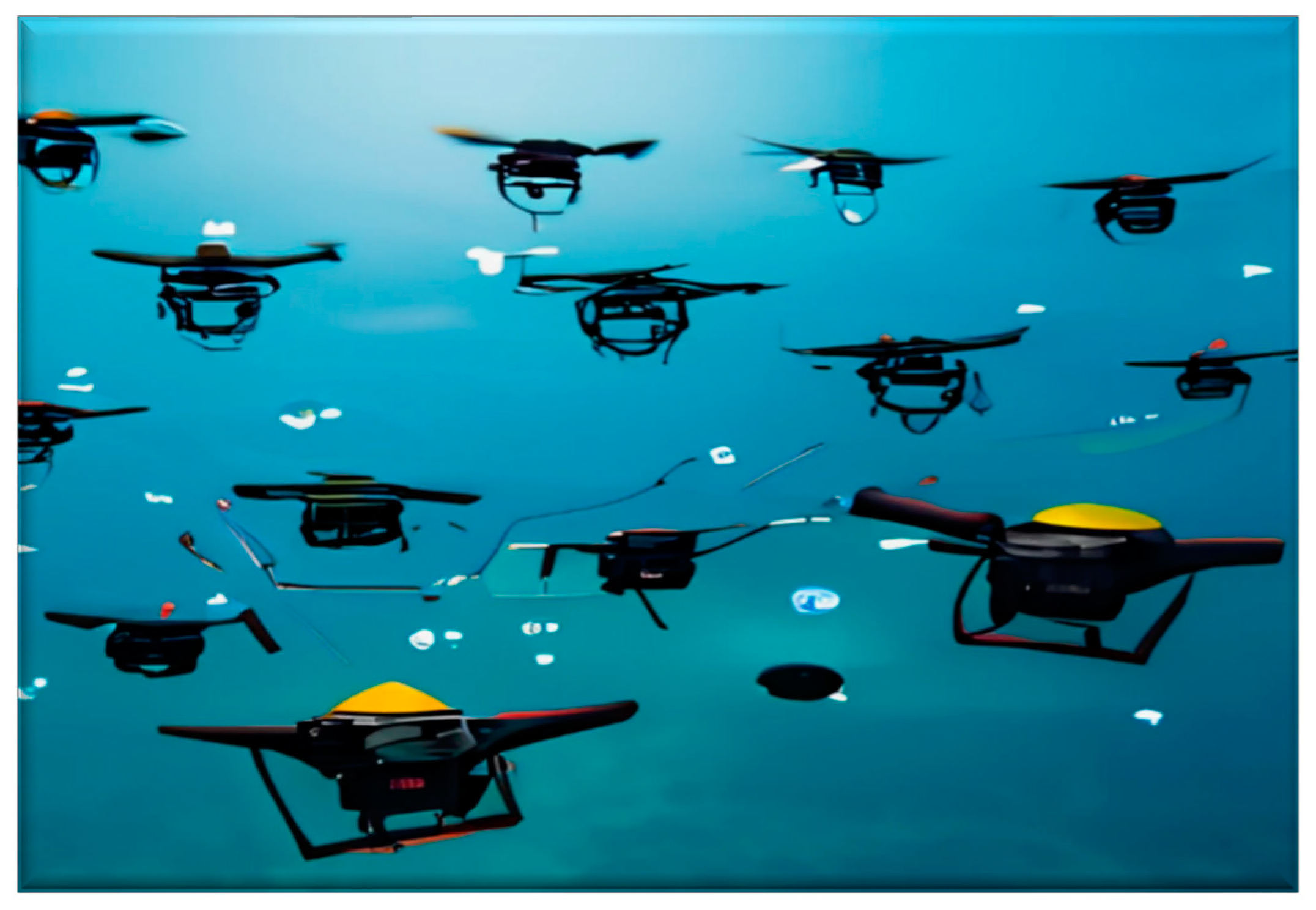
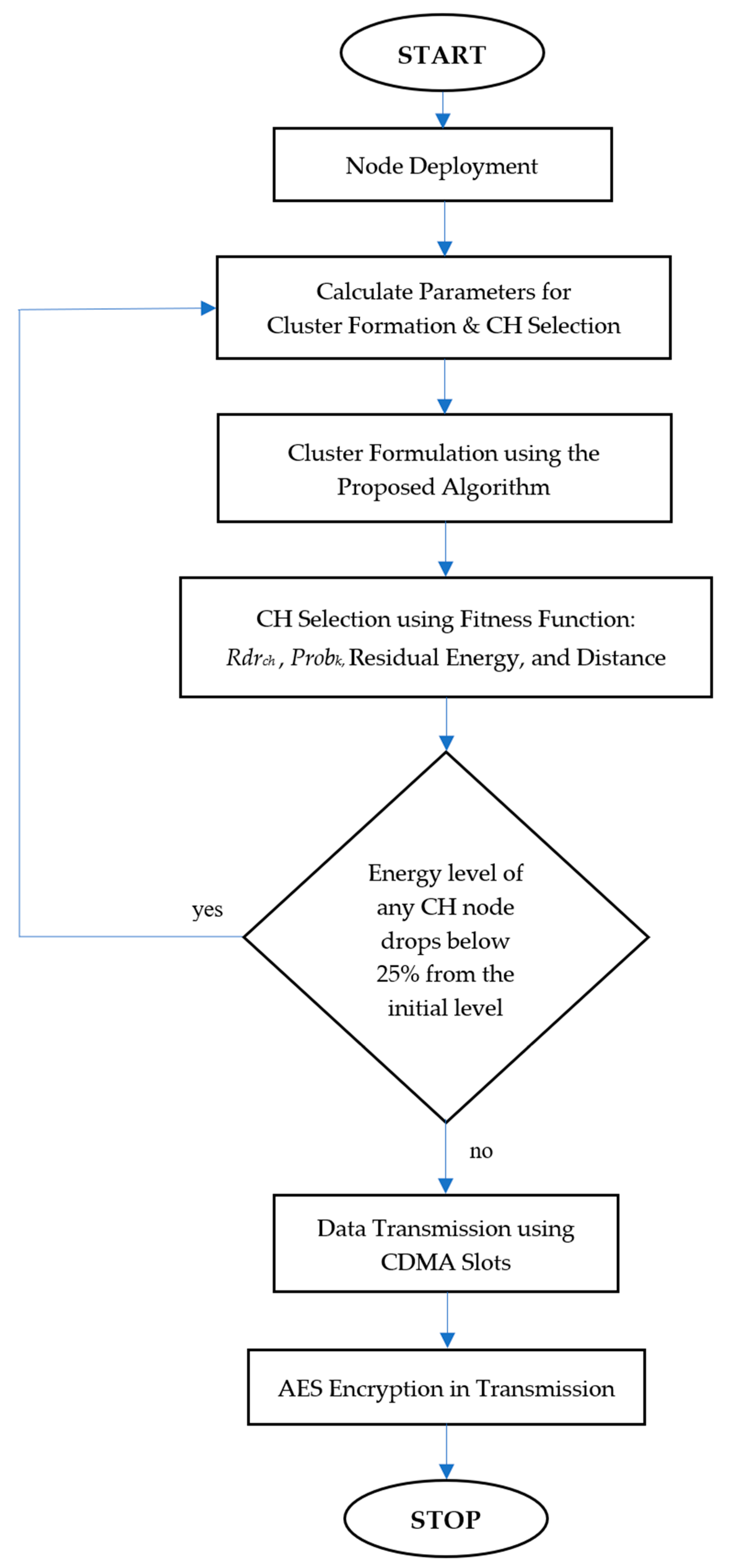
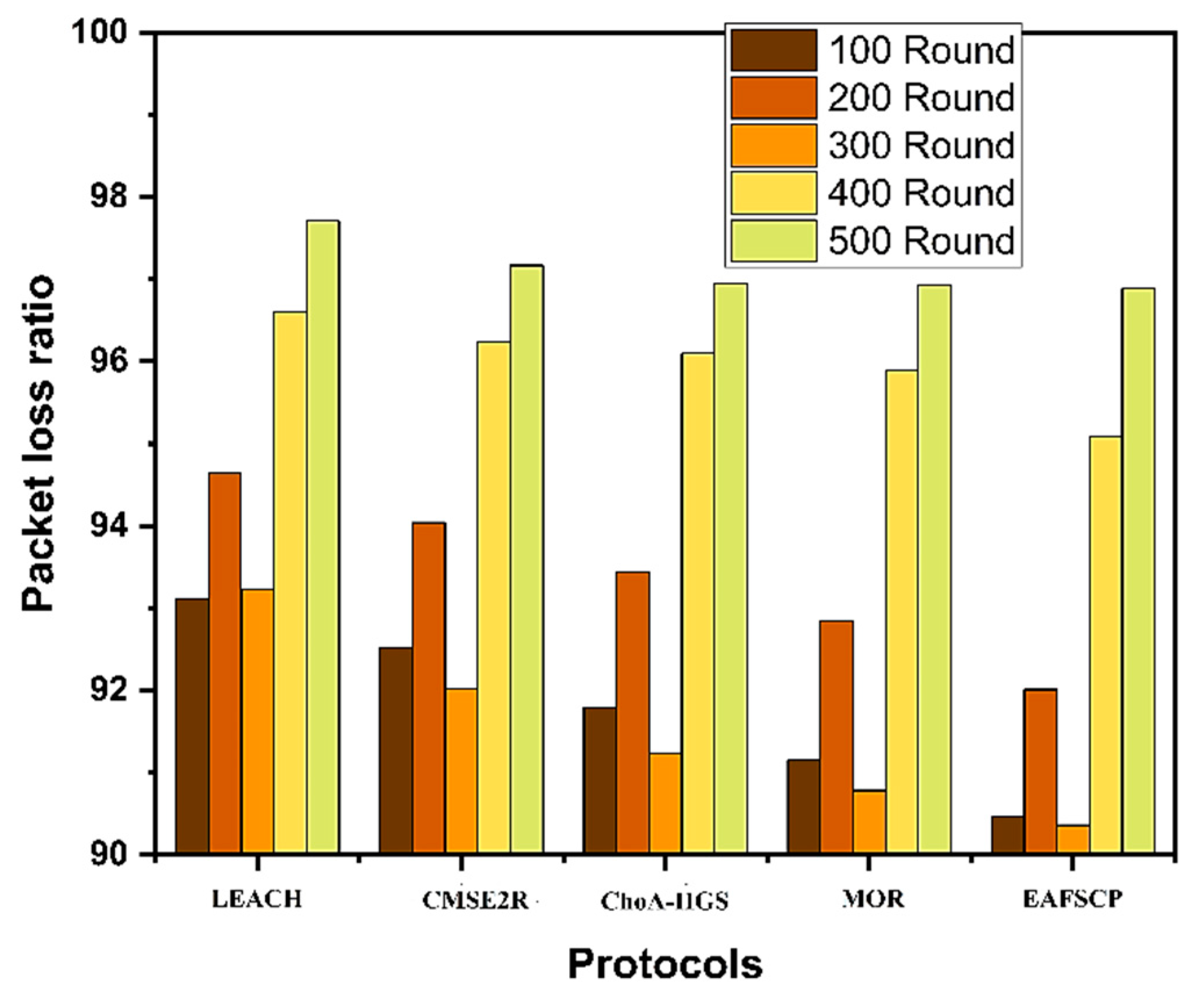
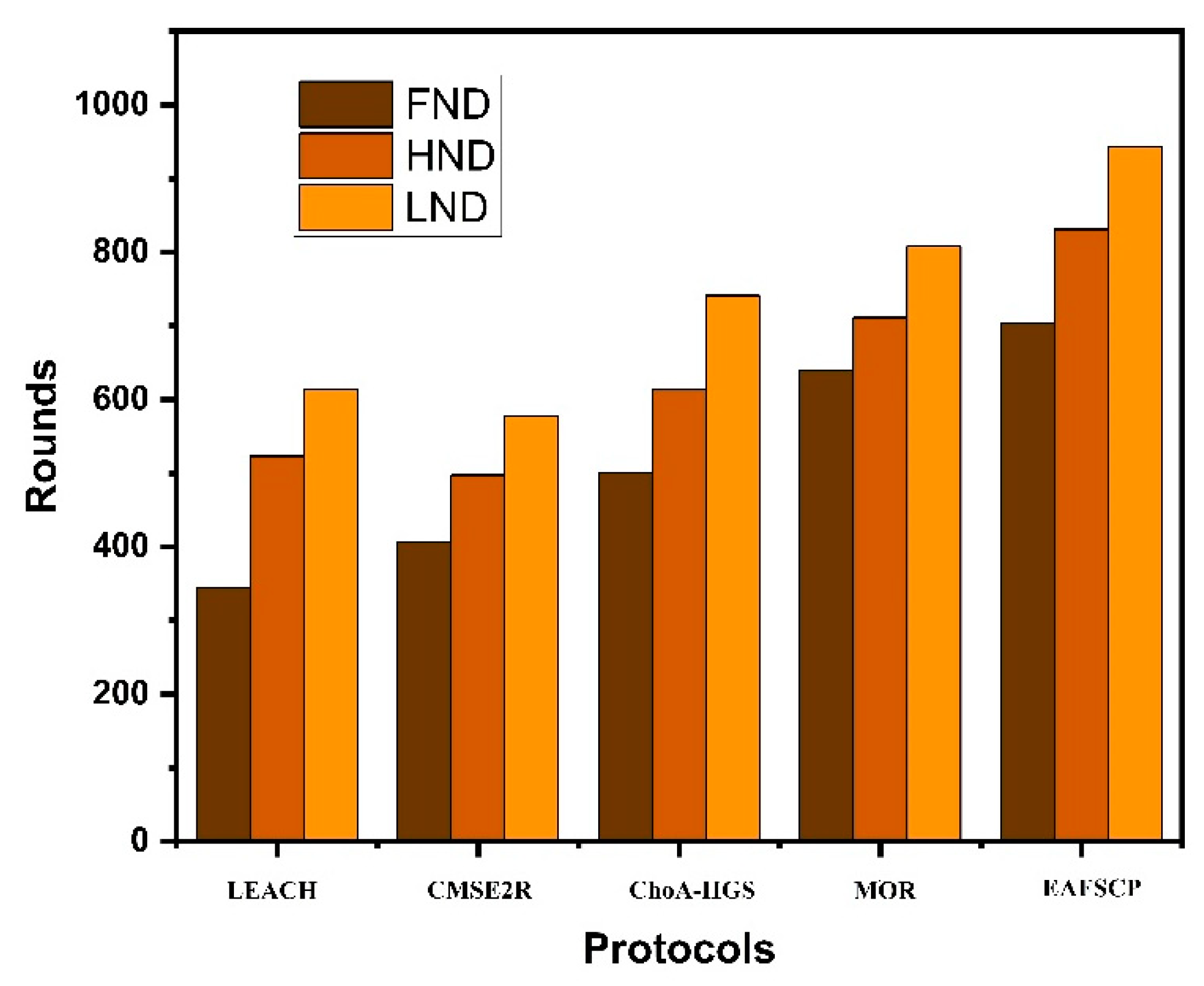
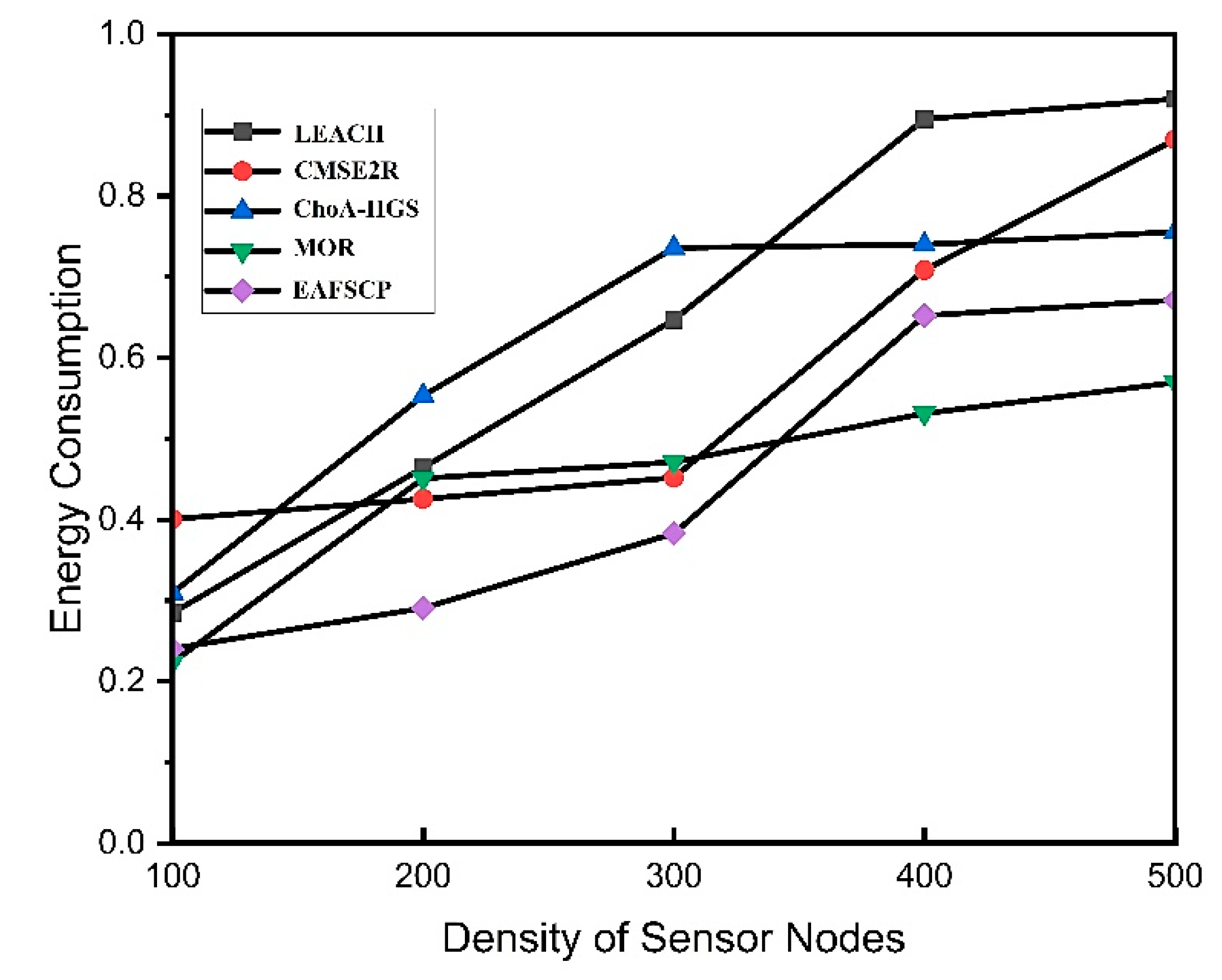
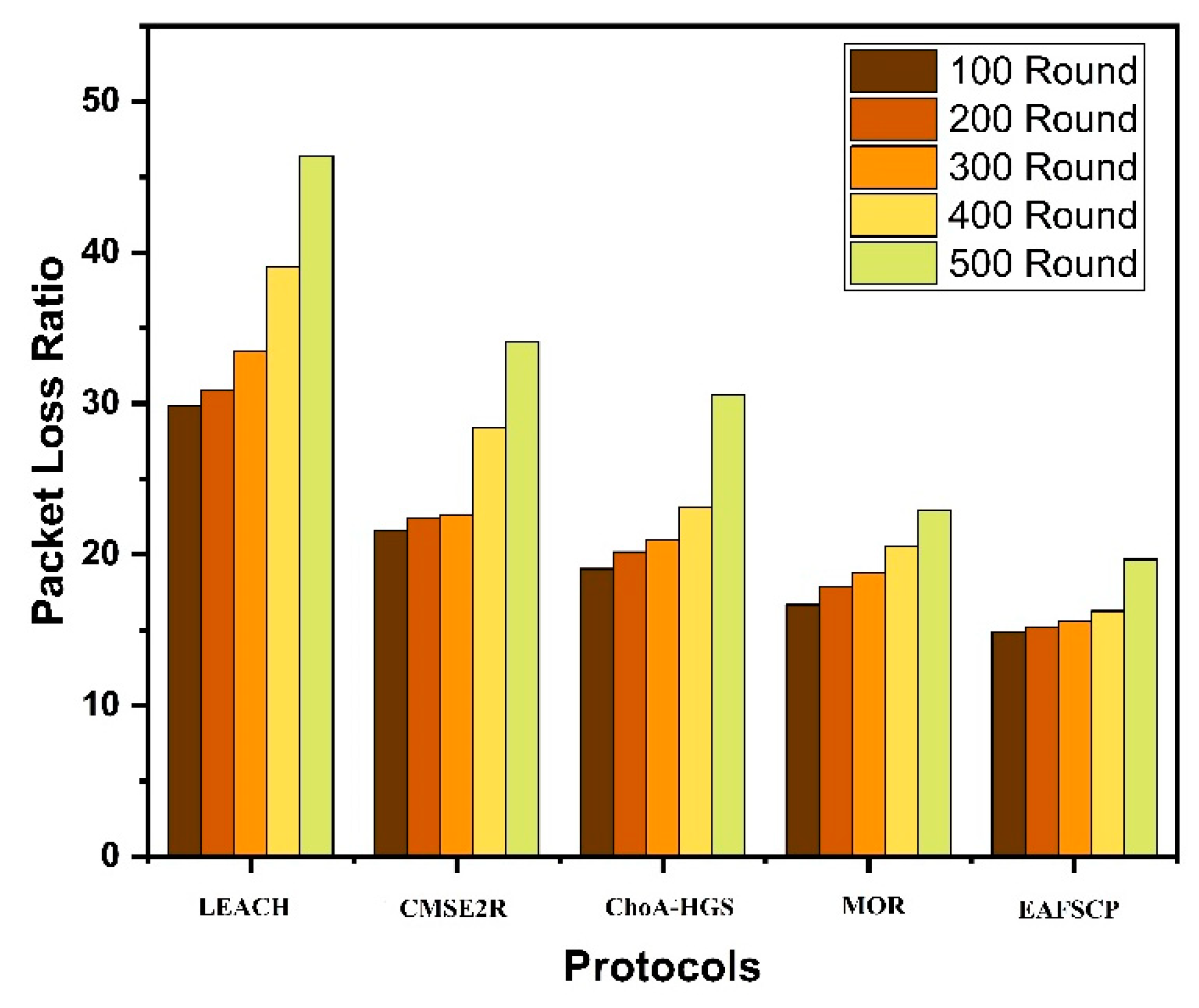
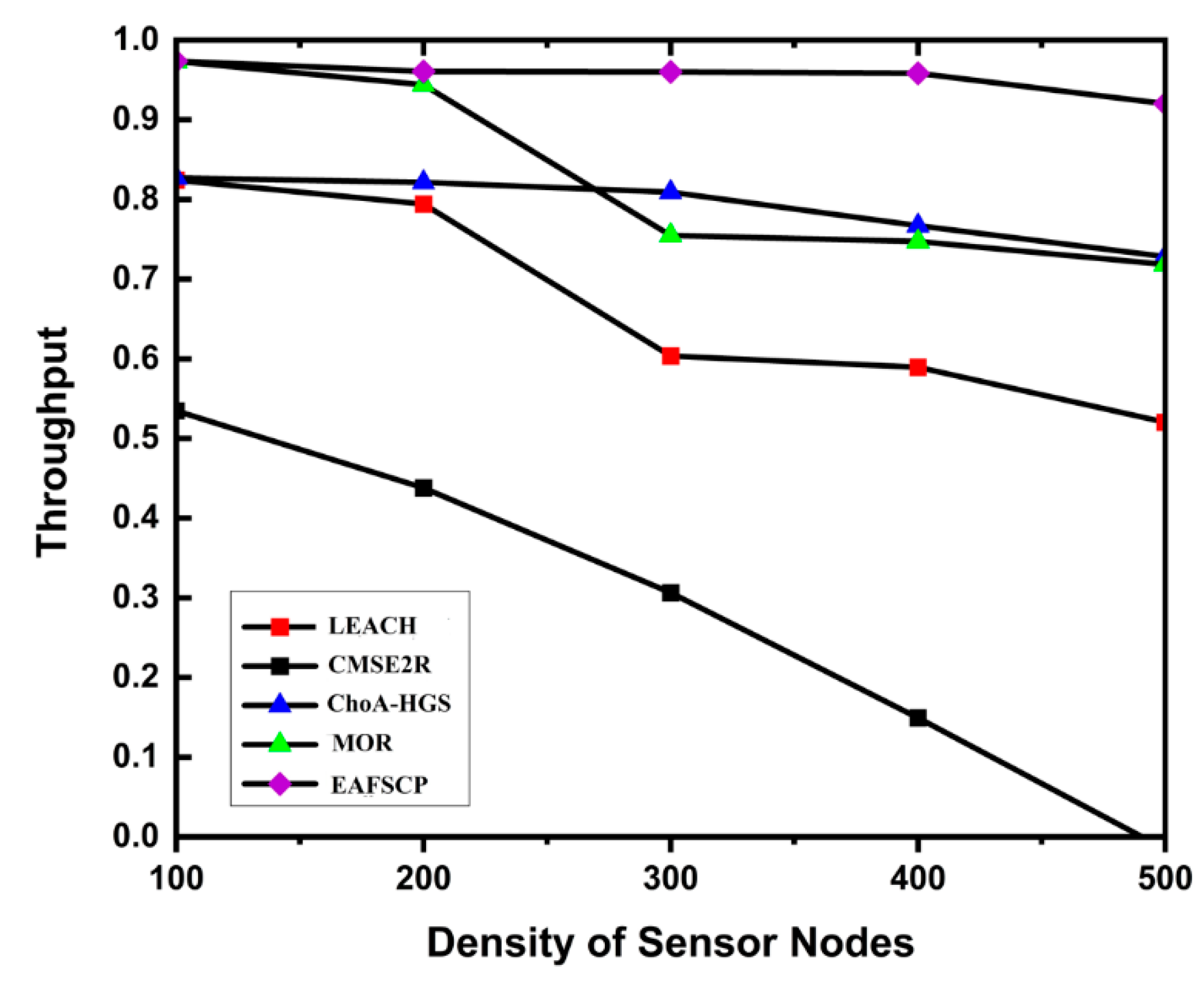
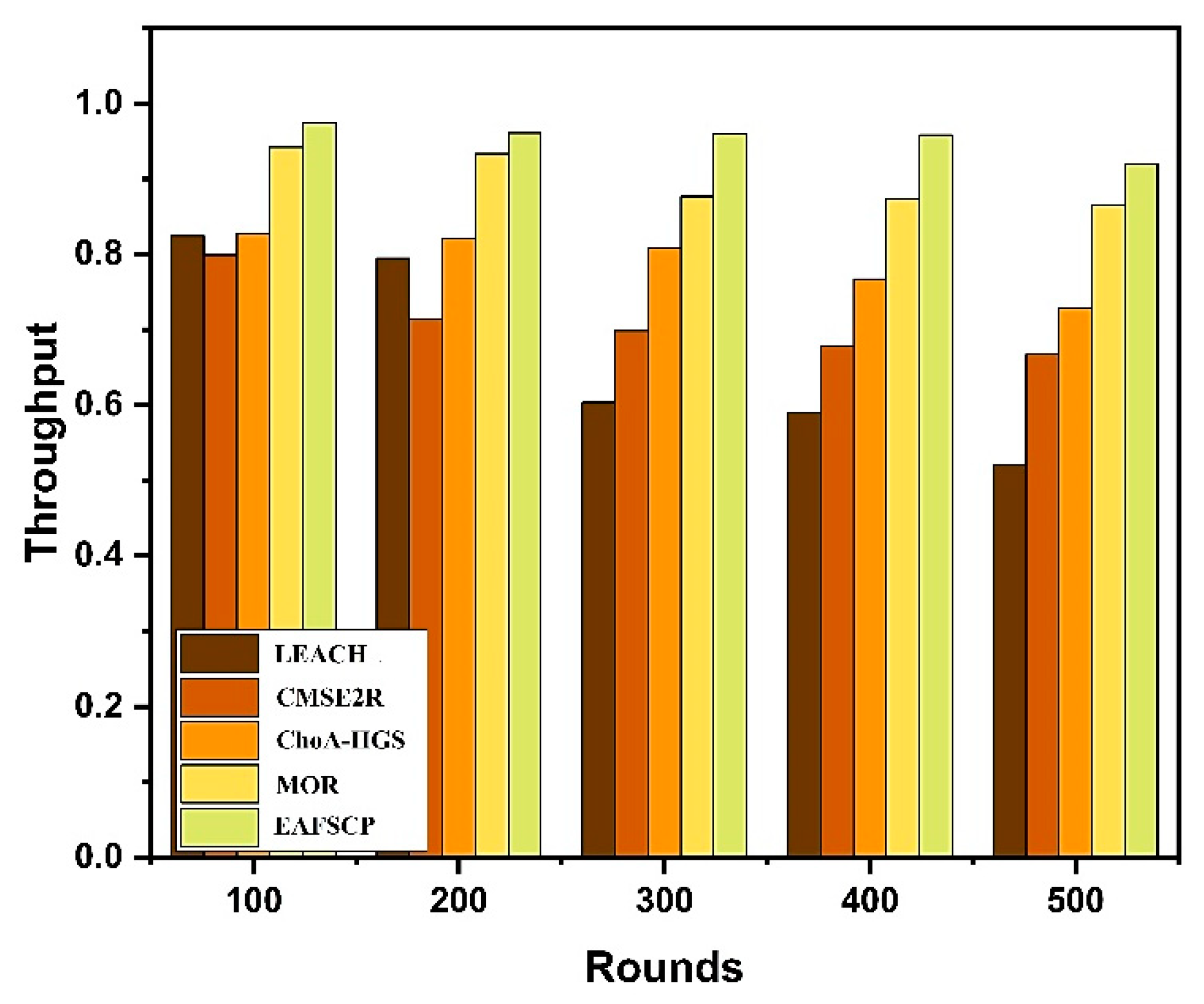
| Protocol | Energy Efficiency |
Scalability | Fault Tolerance |
Reliability | Network Longevity |
Delays | Clustering Overhead | Load Balancing |
|---|---|---|---|---|---|---|---|---|
| LEACH [18] | + | 0 | - | + | - | + | + | 0 |
| I-LEACH [19] | + | + | 0 | + | + | 0 | + | + |
| LEACH-C [20] | - | - | + | - | - | + | 0 | + |
| CACONET [21] | 0 | + | - | 0 | + | - | + | 0 |
| EBECRP [17] | 0 | 0 | - | - | + | + | + | + |
| CBE2R [23] | - | + | 0 | - | - | 0 | 0 | - |
| CMSE2R [24] | + | - | + | 0 | 0 | + | + | + |
| ACUN [25] | 0 | 0 | + | - | - | - | - | - |
| CUWSN [26] | + | - | - | + | - | 0 | 0 | - |
| AMDC [27] | - | - | - | 0 | + | - | - | 0 |
| GEDAR [28] | + | 0 | + | + | - | + | 0 | 0 |
| QERP [29] | 0 | + | - | - | - | - | + | - |
| Protocol | Advantages | Deficiencies |
|---|---|---|
| LEACH [18] |
|
|
| I-LEACH [19] |
|
|
| LEACH-C [20] |
|
|
| CACONET [21] |
|
|
| EBECRP [17] |
|
|
| CBE2R [23] |
|
|
| CMSE2R [24] |
|
|
| ACUN [25] |
|
|
| CUWSN [26] |
|
|
| AMDC [27] |
|
|
| GEDAR [28] |
|
|
| QERP [29] |
|
|
| Parameter | Value |
|---|---|
| Network size | 5 km × 5 km × 2 km |
| Number of nodes | 300, 400, 500 |
| Sink coordinate | (2000, 2000, 0) |
| Data packet size | 1024 bits |
| Receiving power | 50 μW |
| Transmission rate | 1024 bps |
| Density of Sensor Nodes | LEACH | CMSE2R | ChoA-HGS | MOR | EAFSCP |
|---|---|---|---|---|---|
| 100 | 93.12 | 94.64 | 93.23 | 96.61 | 97.71 |
| 200 | 92.52 | 94.04 | 92.02 | 96.24 | 97.17 |
| 300 | 91.79 | 93.44 | 91.24 | 96.10 | 96.95 |
| 400 | 91.15 | 92.85 | 90.78 | 95.89 | 96.93 |
| 500 | 90.47 | 92.01 | 90.36 | 95.09 | 96.89 |
| Protocol | FND | HND | LND |
|---|---|---|---|
| LEACH | 345 | 523 | 613 |
| CMSE2R | 407 | 497 | 577 |
| ChoA-HGS | 501 | 613 | 741 |
| MOR | 640 | 711 | 808 |
| EAFSCP | 703 | 831 | 943 |
| Density of Sensor Nodes | LEACH | CMSE2R | ChoA-HGS | MOR | EAFSCP |
|---|---|---|---|---|---|
| 100 | 0.2848 | 0.4007 | 0.3095 | 0.2333 | 0.2408 |
| 200 | 0.4643 | 0.4257 | 0.5531 | 0.4511 | 0.2806 |
| 300 | 0.6470 | 0.4519 | 0.7358 | 0.4711 | 0.3730 |
| 400 | 0.8950 | 0.7084 | 0.7400 | 0.5415 | 0.6221 |
| 500 | 0.9199 | 0.8700 | 0.7557 | 0.5695 | 0.6415 |
| Average | 0.6422 | 0.5713 | 0.6188 | 0.4533 | 0.4316 |
| Protocol/Rounds | 100 | 200 | 300 | 400 | 500 |
|---|---|---|---|---|---|
| LEACH | 29.85 | 30.87 | 33.48 | 39.06 | 46.41 |
| CMSE2R | 21.59 | 22.44 | 22.65 | 28.39 | 34.09 |
| ChoA-HGS | 19.04 | 20.17 | 20.94 | 23.16 | 30.56 |
| MOR | 16.67 | 17.88 | 18.78 | 20.57 | 22.95 |
| EAFSCP | 14.89 | 15.19 | 15.55 | 16.25 | 19.67 |
| Density of Sensor Nodes | LEACH | CMSE2R | ChoA-HGS | MOR | EAFSCP |
|---|---|---|---|---|---|
| 100 | 0.8243 | 0.7988 | 0.8271 | 0.9420 | 0.9737 |
| 200 | 0.7944 | 0.7143 | 0.8214 | 0.9332 | 0.9608 |
| 300 | 0.6036 | 0.6985 | 0.8092 | 0.8765 | 0.9601 |
| 400 | 0.5894 | 0.6781 | 0.7672 | 0.8742 | 0.9585 |
| 500 | 0.5204 | 0.6677 | 0.7284 | 0.8655 | 0.9201 |
Disclaimer/Publisher’s Note: The statements, opinions and data contained in all publications are solely those of the individual author(s) and contributor(s) and not of MDPI and/or the editor(s). MDPI and/or the editor(s) disclaim responsibility for any injury to people or property resulting from any ideas, methods, instructions or products referred to in the content. |
© 2023 by the authors. Licensee MDPI, Basel, Switzerland. This article is an open access article distributed under the terms and conditions of the Creative Commons Attribution (CC BY) license (http://creativecommons.org/licenses/by/4.0/).





